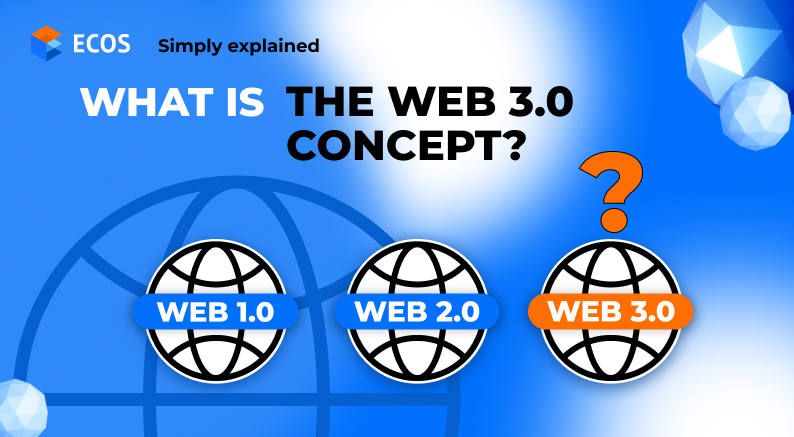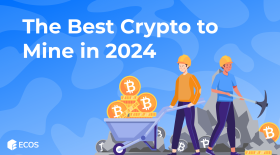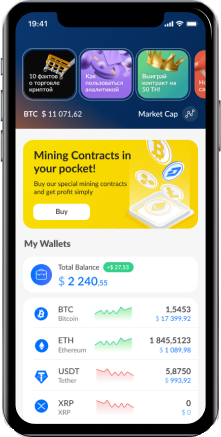What is the Web 3.0 concept and why it is needed

We live in a time of profound transformation when every day brings new things, technologies, and conceptions. The Internet and its global network are among such contemporary phenomena that change the world in a million possible ways. They provide endless opportunities for the development and introduction of a new reality for our society. The Web 3.0 concept is a great example that is worth talking about in more detail.
The background of Web 3.0
What is Web 3.0 and how does it work? In a few words, it can be defined as the upcoming third-generation internet when machines would process content in a humanlike way. It is preceded, just like its name implies, by Web 1.0 and Web 2.0. All these Internet versions were formed step by step, without abrupt transitions and tremendous shifts from the earlier stage to the next one. The network was developing, new functions emerged on websites, usage of the Internet was taking new unexpected forms and contents, and one day users realized that they came across absolutely different infrastructure. No doubt, the same will be true for a new phase of the Internet evolution.
But speaking of this new stage of the Internet development, it is necessary to remember that it is at the very beginning of its formation and there is no single well-established definition for it. Nobody knows exactly what we’ll get as a result and if this idea will be successful as its true potential cannot be estimated.
Basics of the Web 3.0 concept
To understand this new iteration of the World Wide Web it is necessary to have a look at the previous ones. Web 1.0 can be characterized as a time of readers but not creators. Users were passive consumers of the online content and their interaction with it was static. Things changed with Web 2.0 when the users’ interaction with the content became dynamic. This is the time of blogs, social media, and other platforms where users create most of the content. In this case, the main disadvantage is that you need to provide too much personal information to companies that run these platforms.
Web 3.0 should improve this situation as it seems to reorganize the online space totally. Its critical characteristic should be
- decentralization. Data will be interconnected in a decentralized way and be distributed between users without third parties and interlayers.
- transparency. The software solutions will be mainly open-source and this will allow understanding how they work and interact with users.
- privacy. It will not be necessary to provide your personal information to third-party companies to get access to online space.
- accessibility. The transparency of a decentralized network means that neither party can take control over the data or restrict access. Any person can create or use various apps without the permission of a centralized head company.
- adaptedness. Advanced machine learning techniques will facilitate the interaction between you and Internet. The content you consume is completely adapted for your personal needs and no matter how you communicate with the Internet: with the text, voice, or any other way.
The shortest and simplest formula of Web 3.0 can be put as Read + Write + Own. All components are crucial and cannot be ignored.
Blockchain and cryptocurrencies
Blockchain technologies seem to become an integral and natural part of the upcoming Web 3.0 due to their decentralized nature. Decentralized systems of Bitcoin and Ethereum have revolutionized the online space and made a serious step towards the new Internet. They changed the user experience and interaction in the common digital space.
This means that tokens and cryptocurrencies may be used for the development of absolutely new business models. In the epoch of Web 3.0, search engines, social media platforms, marketplaces, etc. will be built on the blockchain and supported by cryptocurrencies. Crypto makes it possible to avoid government or bank regulations.
Cryptocurrencies are defined as programmable money and their programmability greatly increased after the introduction of smart contracts. You can often come across the phrase “Web 3.0 cryptocurrencies.” In fact, it usually means just decentralized projects that use smart contracts and automate transactions but it also demonstrates a strong association between Web 3.0 technologies and cryptocurrency development. There are numerous lists of the best Web 3.0 tokens that can be found on various platforms.
As a result, new digital economies are created due to blockchain technologies and decentralized transactions. This transparency and accessibility lead to better financial services for all people no matter where they live. The only thing they need is access to the Internet.
Web 3.0 as an opportunity booster
One of the key advantages of Web 3.0 is an opportunity to make money on Internet platforms not only for their owners and stakeholders but for other users. That is why it’s high time to explore this issue to find your own way to make a profit from it. Pay closer attention to it if you are
- startuper of investor. The number of investments in crypto projects is soaring. The choice of niches is immense, from digitalization of the business processes up to distributed systems creation.
- technician. As this sector evolves, more and more specialists are required. These are not only developers but marketing consultants, sales managers, and other experts.
- Internet user. The Web 3.0 concept opens great opportunities for content creators. They can monetize their work by means of tokens or NFT.
Web 3.0 today and tomorrow
As we’ve already mentioned above, this concept is not yet completely introduced to our everyday life. Now we are at the very start of the embodiment of this idea but we have already faced some Web 3.0 examples. This makes us believe that this is not just a speculative imagination but something real we can aspire to.
The main common requirement of Web 3.0 apps is their ability to deal with large data amounts and transform them into execution expected by users. Today, Amazon, Apple, and Google offer some products that can be classified as Internet 3.0 apps.
Siri and Alexa virtual assistants, computational knowledge engine Wolfram Alpha, or connected smart homes are the current reality of our world. Some decades ago we couldn’t even imagine such a level of voice recognition or ubiquity intrinsic to Web 3.0 technologies.
But when could we expect the complete Internet generation change? When will we be sure that we have already stepped into the new epoch? There is no answer to this question as many experts believe that the model of the absolutely decentralized Internet is unreal. Even some new Internet segments like NFT or metaverses are actually under the control of specific organizations. In the near future, a hybrid Internet model that includes some Web 3.0 elements appears more probable.
The bottom line
The future is nearer than it may seem. The Web 3.0 concept is an indication of these universal changes that may lead us to an absolutely new reality. The Internet tends to become more decentralized while blockchain and cryptocurrencies will help to achieve this aim.
Web 3.0 is meant to implement the ideas of transparency, ubiquity, and artificial intelligence eliminating the distinction between the physical and the digital. Is it possible? We believe it is.









